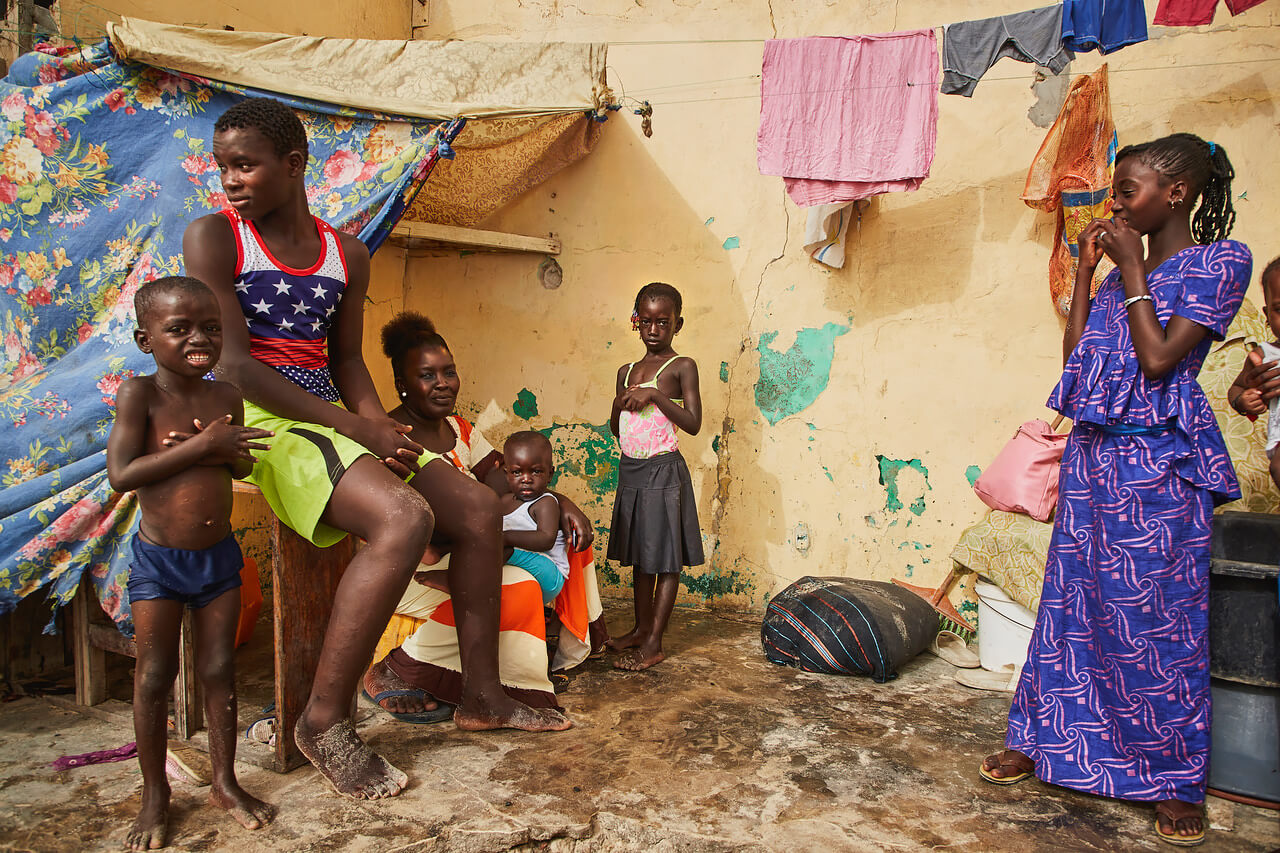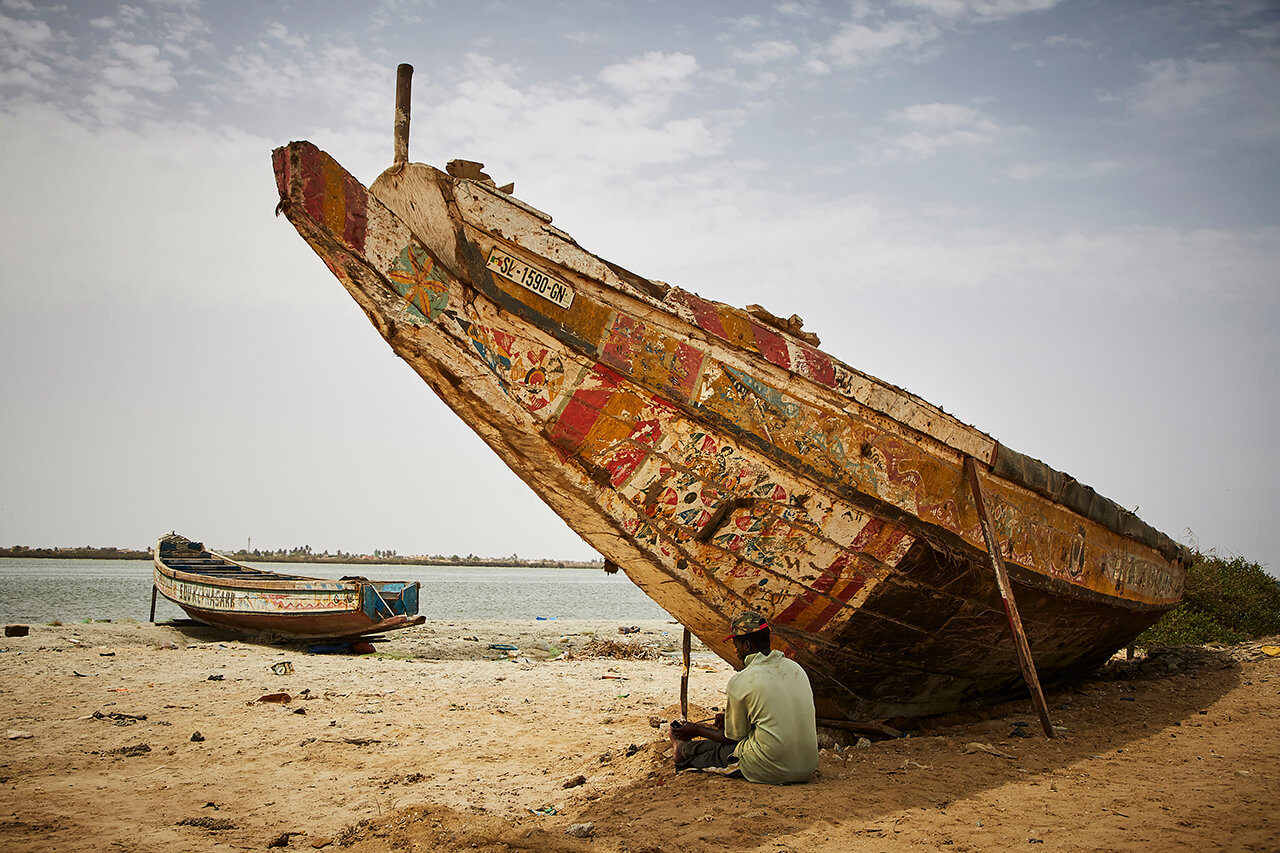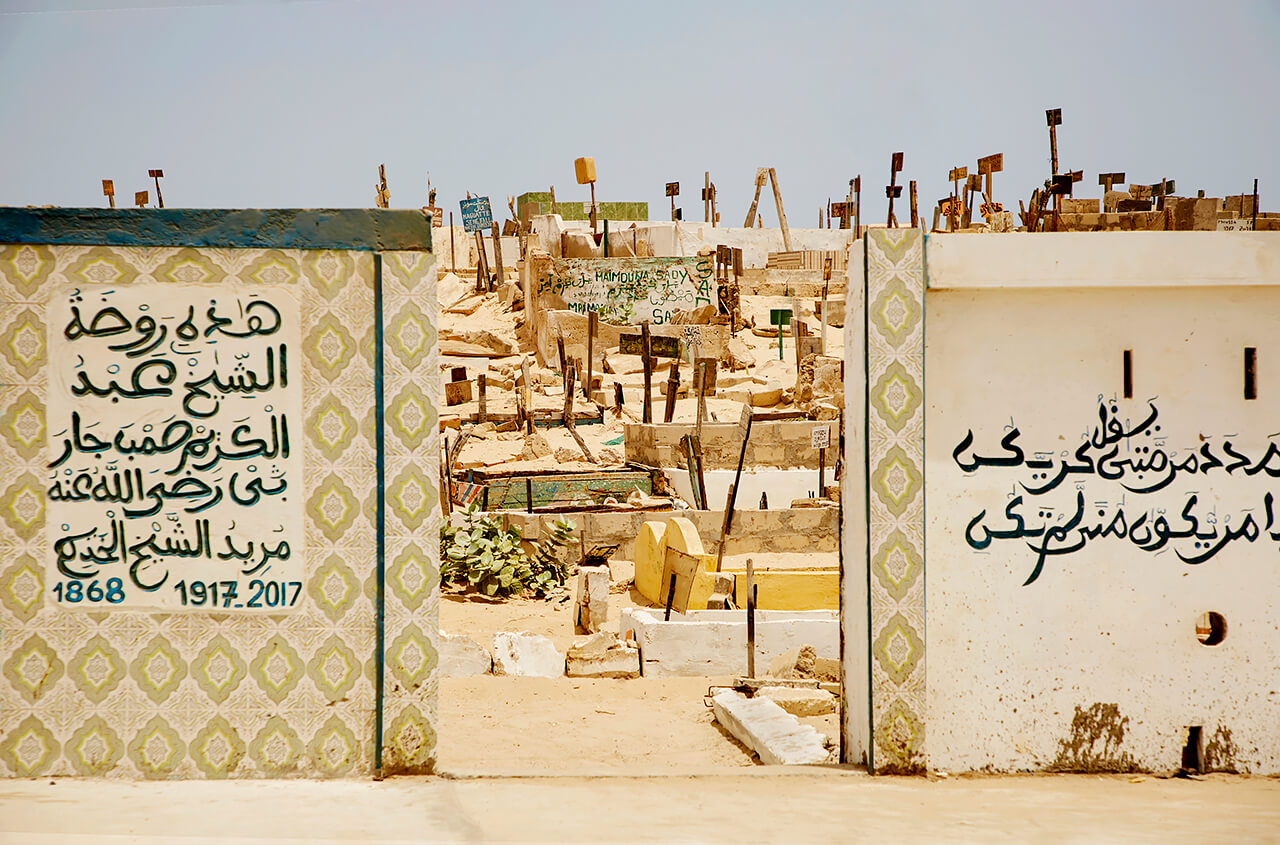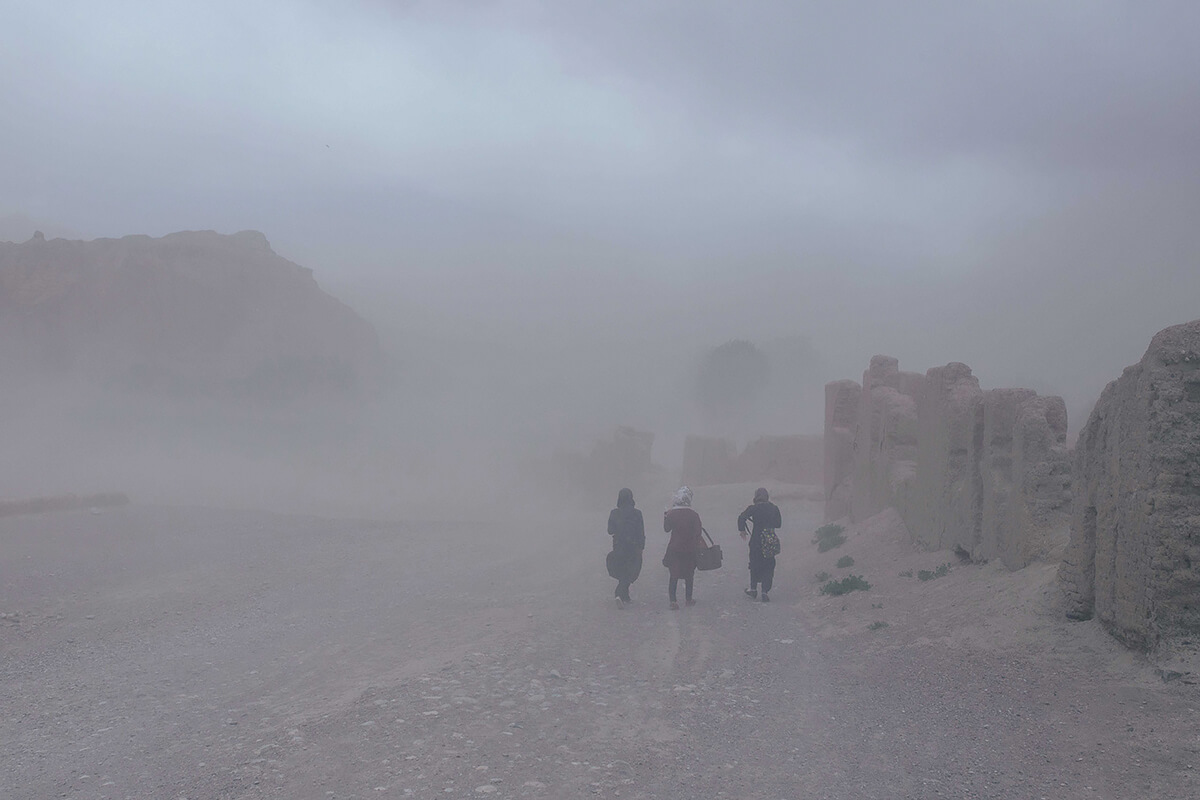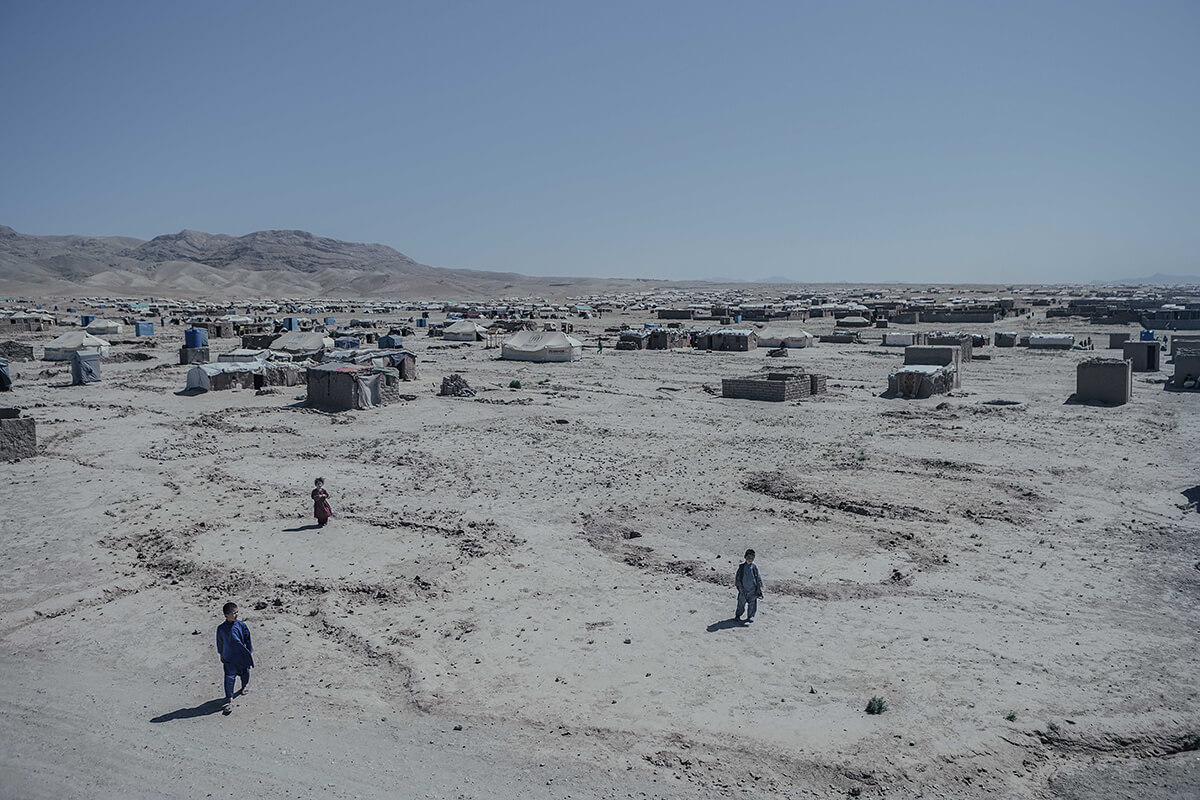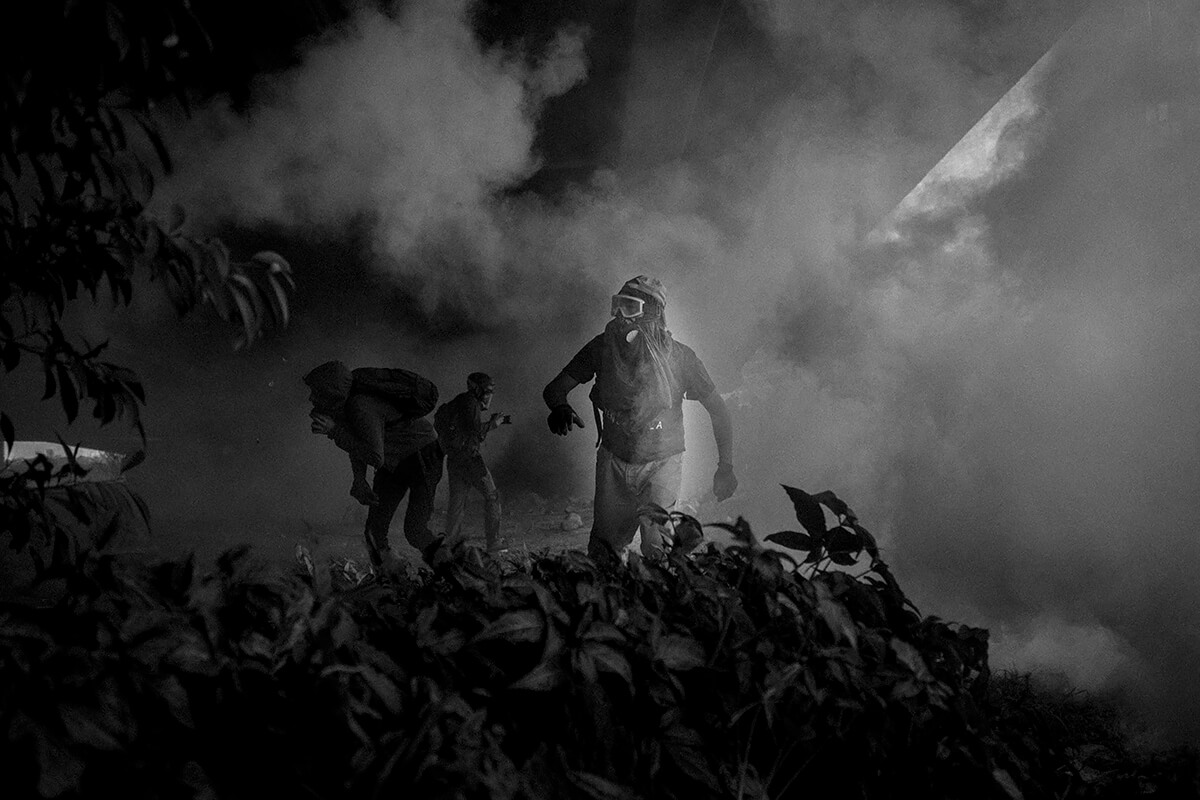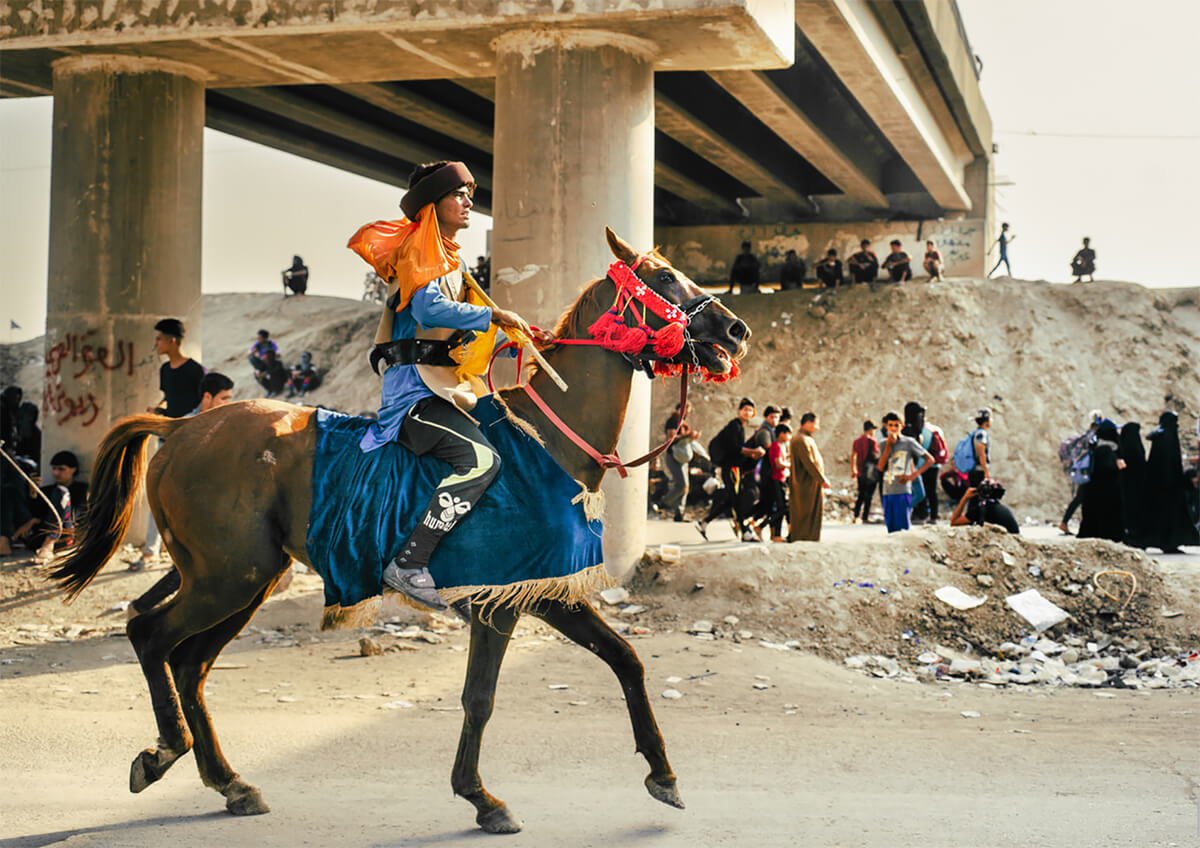FotoDocument and
Nikon are pleased to announce that the Marilyn Stafford FotoReportage Award 2020 winner is Nicky Quamina-Woo. Honourable Mentions have been awarded to Solmaz Daryani (runner up), Fabiola Ferrero, Emily Garthwaite, Ana Caroline de Lima, Emilienne Malfatto, Nadège Mazars and Valentina Sinis.
Nicky Quamina-Woo is an American documentary photographer who divides her time between Africa & New York. Her fascination with the tenacity of the human spirit deeply influences her approach to image making. As a Black woman her work has been centered on exploring the transmogrified effects of trauma within communities. The winning work raises awareness for solutions and development around climate change in Senegal.
Fatou Ngueye, 34, sits within the last 2 remaining walls of her living room -which is now open to the sand and ocean- with her children. The family has been sleeping on the floor of a neighbor’s home for over a year so that her husband, a fisherman, can remain close to the sea for work.
The global competition, supported by Nikon and facilitated by FotoDocument, a not-for-profit photography organisation, celebrates female photographers and highlights the positive power of photojournalism to reveal and explore the most important issues facing our people and planet.
The winning project is
As The Water Comes. Africa, with its abundant natural resources, is often overlooked when it comes to environmental issues though it suffers heightened effects of desertification, soil erosion, and insect infestations. One such issue is in northern Senegal, where hundreds of families have been evacuated as their houses have been destroyed by the rising sea levels and inhabitants forced to move to tent cities when their homes are no longer habitable. Efforts to deal with these problems are often ignored or severely handicapped by a failure to understand their nature and act on possible remedies that incorporate residents' needs. One such area, Doun Baba Dieye, had to be abandoned as the village was completely submerged in 2009 after authorities dug a channel through a small peninsula that initially protected the residents against the ocean's surge. The hope is that with a larger spotlight pointed at the government through these works, it will start to shift its response to climate change, which needs more public participation and an integration of local knowledge – particularly as it relates to key economic activities like fishing and agriculture.
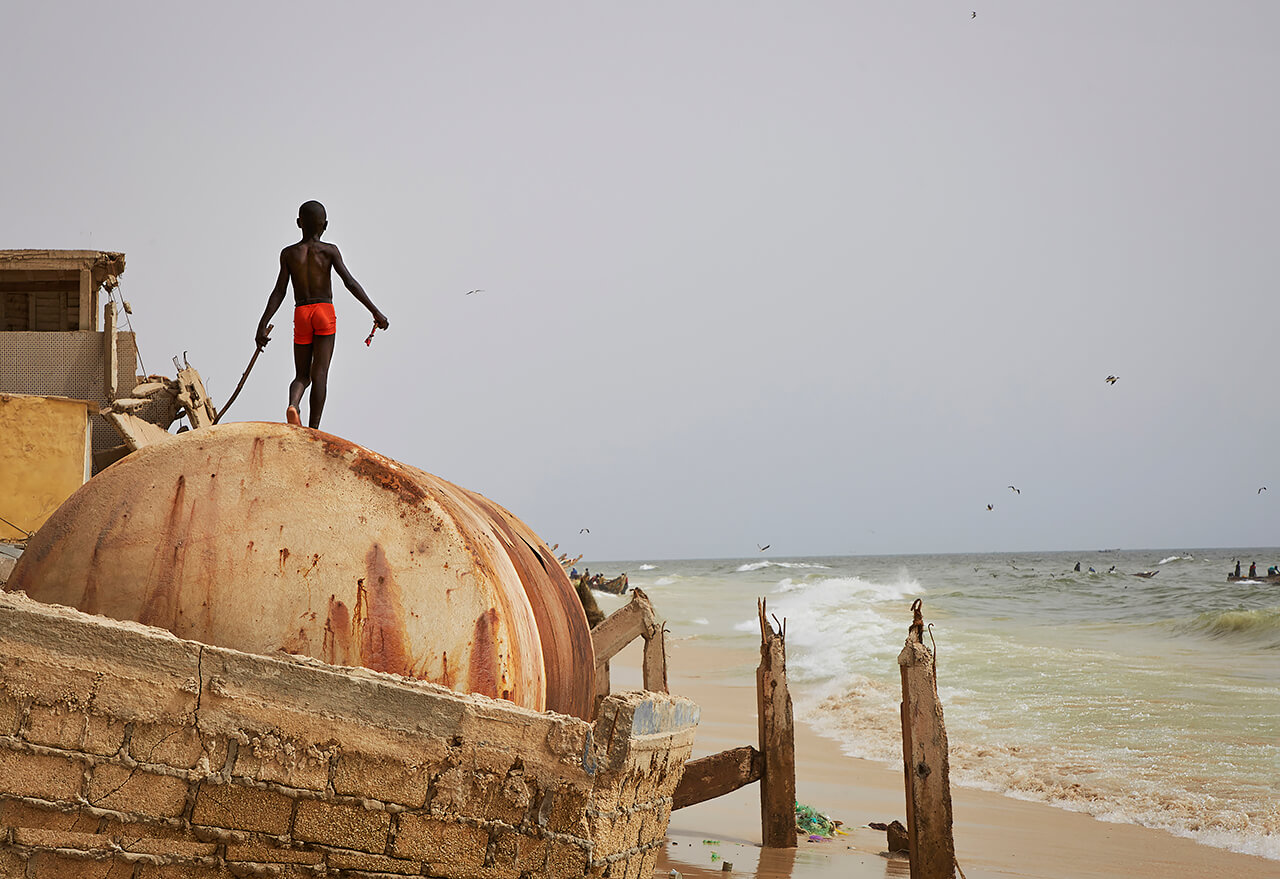
A child plays on the ruins of a sea wall after the ocean surge.
Fisherman, Daoud Diallo, sits under the bow of a boat for shade. He lives in a single room that he shares with 9 other people after his family home became inhabitable due to erosion.
The local cemetery in Saint Louis is also begining to flood. Most people from the region have at least one relative buried here.
Nicky Quamina-Woo is an American documentary photographer who divides her time between East and West Africa & New York. Her fascination with the tenacity of the human spirit deeply influences her approach to image making. As a Black woman her work has been centered on exploring the transmogrified effects of trauma within communities. Specifically, the ways in which collective suffering and its myriad embers can change the underlying ethos of groups to form something new; adaptation not only as a means of survival but morphology that integrates and syncretizes with the culture in the effort of healing.
Nicky Quamina-Woo
Honorable mentions
Solmaz Daryani, Iran (runner up)
Solmaz Daryani is an Iranian photographer and photojournalist, based between the UK and Iran. Her work is particularly known for exploring the themes of climate security, climate change, water crisis, human identity and environment. Daryani has worked internationally, covering social and environmental documentary stories in Iran, Afghanistan, Turkey and the United Kingdom. Her work has been published by international magazines and newspapers such as National Geographic Magazine, L’OBS Magazine, Foreign Policy Magazine, Polka Magazine, Zenith Magazine among others.
Afghanistan: Between Climate & Conflict
Afghanistan is ranked as one of the most vulnerable countries in the world to climate change, and one of the least equipped to handle what’s to come. Every year, droughts, floods, avalanches, and landslides seem to worsen, driving mass migration, poverty, and destabilization. This story is seeking to address the effects of climate change on women (particularly schoolgirls), farming families, population growth and rising conflict in Afghanistan. There is a body of evidence which concludes that the best way to build resilience to climate change is to focus on girls and women – education, contraception, opportunity. Addressing women and food security would involve solutions such as education and using environmentally friendly farming for improving gender equality and food self-sufficiency. Educated and independent Afghan women will offer hope to climate resilience.
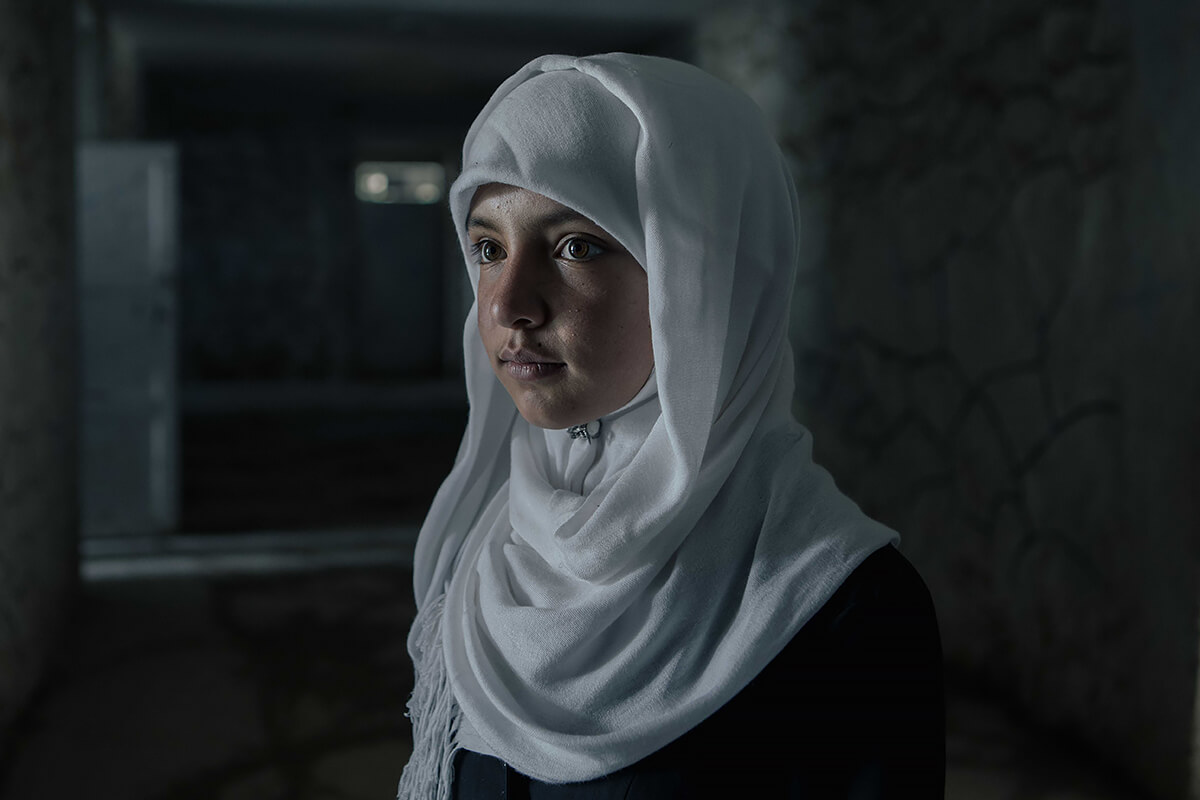
Ameneh,12, studies in 6th grade at Markazi high school in Bamyan. Her friend left the school last year because her father, who was a farmworker - moved to Kabul to find a job. According to Mr.Abdul Ghayom Afshar, the director of the Shirin Hazara High school, out of 2,000 students, 400 students could not enrol in school last year, due to the drought effect on the financial situation of agriculture-dependent families. Bamyan. Afghanistan.
While going to school, Afghan girls find themselves in an unexpected dust storm in the old city of Bamyan. Bamyan is located in Afghanistan’s Central Highlands with steep mountain slopes, deep valleys, and harsh winters – this area has experienced extremes of climate and weather in recent years. Bamyan valley. Afghanistan.
Tents and makeshift shelters dot the sprawling Shahrak-e-Sabz camp for internally displaced people on the outskirts of Herat, Afghanistan’s third largest city. Here, many families survive on a single meal a day. Herat, Afghanistan.
is a journalist and photographer born in Caracas in 1991. Her personal work is the result of how her childhood memories contrast with nowadays Venezuela, her home country. Looking to portray its crisis beyond the news, emotion is a key element in her storytelling. Among her recognitions are the Emerging Vision Award 2017 by DPF, World Press Photo Talent Program South America 2018 and Magnum Foundation Photography and Social Justice Fellowship. Fabiola collaborates often with international media, such as The New York Times, Bloomberg and Le Monde.
Blurred In Despair
Blurred in Despair aims to portray a collective mental state. Venezuela’s crisis involves a lot more than numbers and money. The increasing hostility of daily life has created debilitating psychological trauma for citizens, and people have begun to feel lost in their quest for survival. According to the “Emotional Map”, a study conducted by Venezuelan psychologist Yorelis Acosta, it appears that the country is collectively in a state of depression due to relentless exposure to hostile situations. When survival becomes a priority, happiness becomes a blurred concept. Blurred in Despair is a vehicle to educate my fellow countrymen about depression through public presentations in partnership with Yoreslis Acosta to help prevent fatal consequences.
Protesters look for protection from tear gas and rubber under a bridge during a confrontation with the National Guard on April 6, 2017 in Caracas, Venezuela.
is a British photojournalist, Forbes 30 Under 30, and Leica Ambassador focusing on humanitarian and environmental issues. She has a Masters in Photojournalism and Documentary Photography from the University of Westminster and has exhibited her work internationally, including at the World Economic Forum in Davos, Switzerland as well as the South Bank Centre and The Natural History Museum in London, UK. She has walked over 500km through Iraq documenting positive stories of resilience and empowerment and co-directed The 40th Day, a documentary covering Arbaeen, the world’s largest annual pilgrimage through Iraq.
The Road To Arba'een
Arba’een is the world’s largest annual pilgrimage. Each year, as many as 25 million Shi’a Muslims converge on southern Iraq to mark the end of a 40-day mourning period. Pilgrims travel from all over the world to walk the 50 miles between the holy cities of Najaf and Karbala. In doing so, they form a vast community that promotes peace and solidarity alongside their deep faith. Despite the unparalleled scale, and despite being both the largest number of people fed for free and the biggest volunteer gathering in the world, the commemoration is rarely covered by international media. Arba’een is of great importance both for Iraq and the Shi’a, but also for the wider region. It has endured great hardships, having been banned by Saddam Hussein, and remains a magnet for terrorist attacks. Today, its very existence speaks of resilience and offers a window into innumerable and significant stories.
Ana Caroline de Lima, Brazil
Born in São Paulo, Brazil,
Ana Caroline de Lima is an award-winning photographer, journalist and post graduate in anthropology. She believes that cultural and social immersion plays a crucial role in the documentary process, which has lead her to live and work in communities such as the Rajasthani in India, the Quechua in Ecuador and Peru, the Black Hmong in Vietnam and many indigenous communities in Brazil such as the Rikbaktsa, Yawalapiti and Xavante. Her work focuses on cultural practices, environmental and gender issues in traditional societies. She was nominated for the Royal Photography Society’s 100 heroines in 2018. Her work has been exhibited in more than 20 countries, in places such as the NUMA, Getty Museum and Oxo Tower in London.
Rikbaktsa
The Rikbaktsa people are immemorial inhabitants of the Amazon – they had their the first contact with non-indigenous people in the 1960s. This contact brought diseases like the flu and measles, which decimated 75% of their people, as there were no viruses like those in the jungle previously. The pandemic has brought back the same fears their parents faced: a new, unknown disease, along with economical, cultural and environmental issues. The project shows how indigenous people are dealing with covid-19 – how they are trying to recover and face the world again. The work is created from the point of view of the indigenous people to shine a light on the struggles present within the tribes and to help non-indigenous people understand how to practise a better way of living.

Marcelino shows a mutum-carijó' hunted minutes before. The Rikbaktsa are constantly fighting for their rights, territory and culture, but their traditions are alive, they do everything they can to transmit the meaning of their rites and adornments to new generations, as chief Chico says: “Our culture is in everyday life. The way we prepare our food, what he hunt, our adornments. Everything has a meaning. Children must learn it. We, the Rikbaktsa are adapting, but it doesn’t mean that we are disappearing. We are here. We are alive.”
is an independent documentary photographer from France. She focuses on post-conflict and social issues, especially in Iraq, developing long-term projects that allow her to have depth and closeness with her subjects. She studied in France and Colombia and graduated from Sciences Po Paris. She then joined Agence France Presse (AFP) and worked in France and in the Middle East. In early 2015 she moved to northern Iraq as a freelancer. She now works mostly in Iraq, with occasional reporting in Europe and Latin America.
Fallen Angels
Fallen angels is a visual and poetic exploration of the invisible: loss, pain, trauma, memories. Through portraiture, still life images and merged photographs, the sequence takes the viewer inside a collectively traumatised community: the Yezidis of Sinjar, in north-western Iraq. On August 3rd, 2014, this religious minority was attacked by the Islamic State group (ISIS). Thousands of people were killed or abducted. Of the half a million Yazidis in the world, more than 300,000 used to live in Sinjar. Today, little is left of this community. Some families came back to what they still consider their homeland – but it feels like a land of ghosts. The living ones are haunted by the dead, the memory of missing relatives and friends never fades. Time has passed, trauma hasn’t. This long-term project aims to raise awareness about this ongoing situation and show possible solutions: part of the work was done in collaboration with a mental health team from Doctors Without Borders (MSF), an NGO which has set up a safe space where people can talk and be heard without judgement or stigma, which is already a gigantic step in such a closed and remote community.
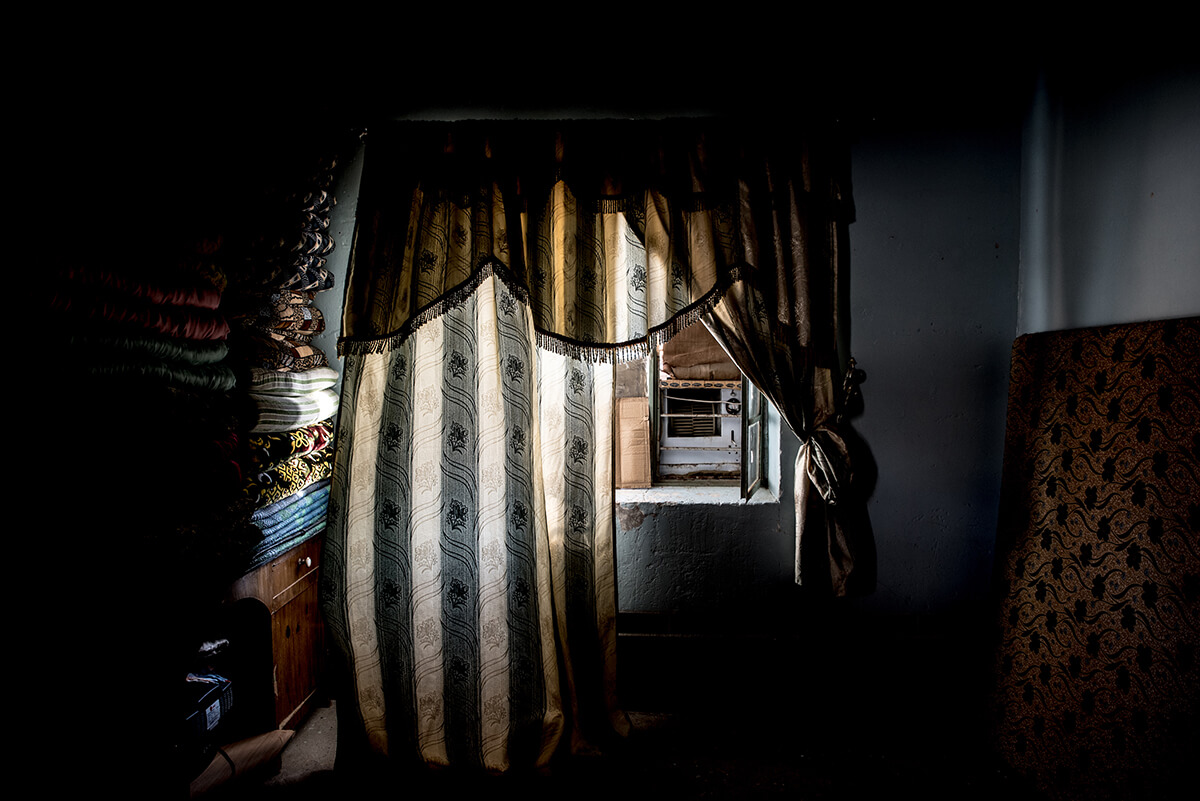
An empty room in the village of Sinuni, north of Mount Sinjar, on September 1st, 2019. In August 2014, the Islamic State organization (ISIS) attacked the Yezidi religious minority living in Sinjar district. As IS fighters advanced into the area, Peshmerga forces withdrew pre-emptively. The attack was followed by a sustained campaign of killings, rapes, abductions and enslavement, and led to a mass migration of Yazidis, mainly to camps in the neighbouring Kurdish region of Iraq. The UN has described ISIS’s atrocities in Sinjar as genocide. People rarely talk about what happened to them or the things that they saw. But five years later, everyone here carries around with them a deep-seated grief about what the Yazidis often refer to as the ‘74th genocide’. The community is grappling with a severe and debilitating mental health crisis, including a high number of suicides and suicide attempts. A mental health survey conducted by Doctors Without Borders in 2018 revealed that 100% of the families had at least one member suffering from some kind of mental illness.
is a French photographer based in Colombia since 2007. Her approach strives to give an intimate insight into the effect of global issues such migration, healthcare system or natural resource extraction. She also explores both the origins of war and the conditions to reach peace in societies such as El Salvador and Colombia. She has twice been a Magnum Foundation grantee, in 2016 and 2019. Mazars has worked on assignment for publications such Wall Street Journal, Libération, Le Monde, Bloomberg Businessweek and Washington Post. She is part of OjoRojo Fábrica Visual, a foundation dedicated to documentary photography in Bogotá.
The Always-Suspected-of-Everything
The project focuses on exploring the security abuses in the fight against gangs in El Salvador. This Central American country has faced violence due to gang presence and it has reached homicide rates that have placed it among the highest in the world. But the tightening of security policies without a public policy of reintegration has led to an excess of arbitrary detentions. Several NGOs as well as a special commission of the United Nations have pointed out these security abuses. The project also has a strong gender dimension: women are most often at the heart of the support for prisoners. The report seeks to raise awareness about security abuses by exposing several undocumented cases of unjust detentions and supporting their defense.
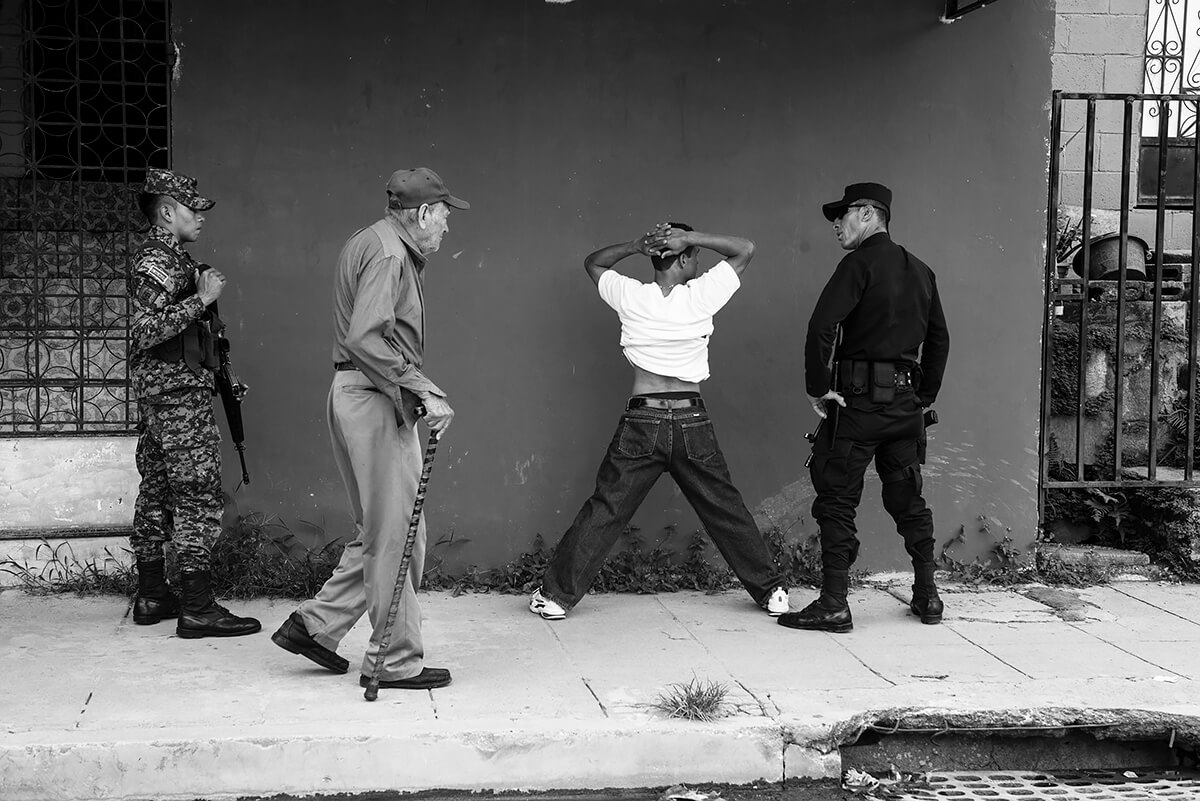
Soyapongo, Jul. 8, 2017: A police patrol assisted by militaries is checking the documents of a “retired” gang member, now evangelist. An old man keeps a concerned eye on the situation. The local population seems suspicious of the police patrol. It is commonly believed by the police that a gang member staysa criminal for life.
is an Italian photographer living and working in China. Her work gravitates toward the quirky and unusual. She is attracted to realities and people that normally don’t get coverage in the media. Her pictures have been published in several international newspapers and magazines. Her works have been showcased in several exhibitions in Europe and China, and she has been a guest on Italian public television in several news broadcasts to present her works, due to the social relevance of the projects.
Broken Princess
Domestic violence and physical abuse at home is a global issue. But nowhere is more prevalent than in societies whose foundation values are still patriarchal. In these societies women have no escape but submission, and those who can’t submit, have very little alternatives. Broken Princess is the story of women in Iraqi Kurdistan who tried to escape the violence by setting themselves on fire. Those who survive are left with terrible physical scars and possibly harder psychological ones: they regret their choice but have a very limited social structure to lean on for recovery. With little support or visibility, they find themselves in a place that is worse, if possible, than before. The project will be a complete body of work, made using photography, video and text. A balanced approach of narrative – daily shots, dreams, suffering, memories, will be paired with factual evidence providing the wider context I am looking for. The actual end result I aspire for is that this body of work acts as a catalyst to provide better opportunities for women to live in better conditions.
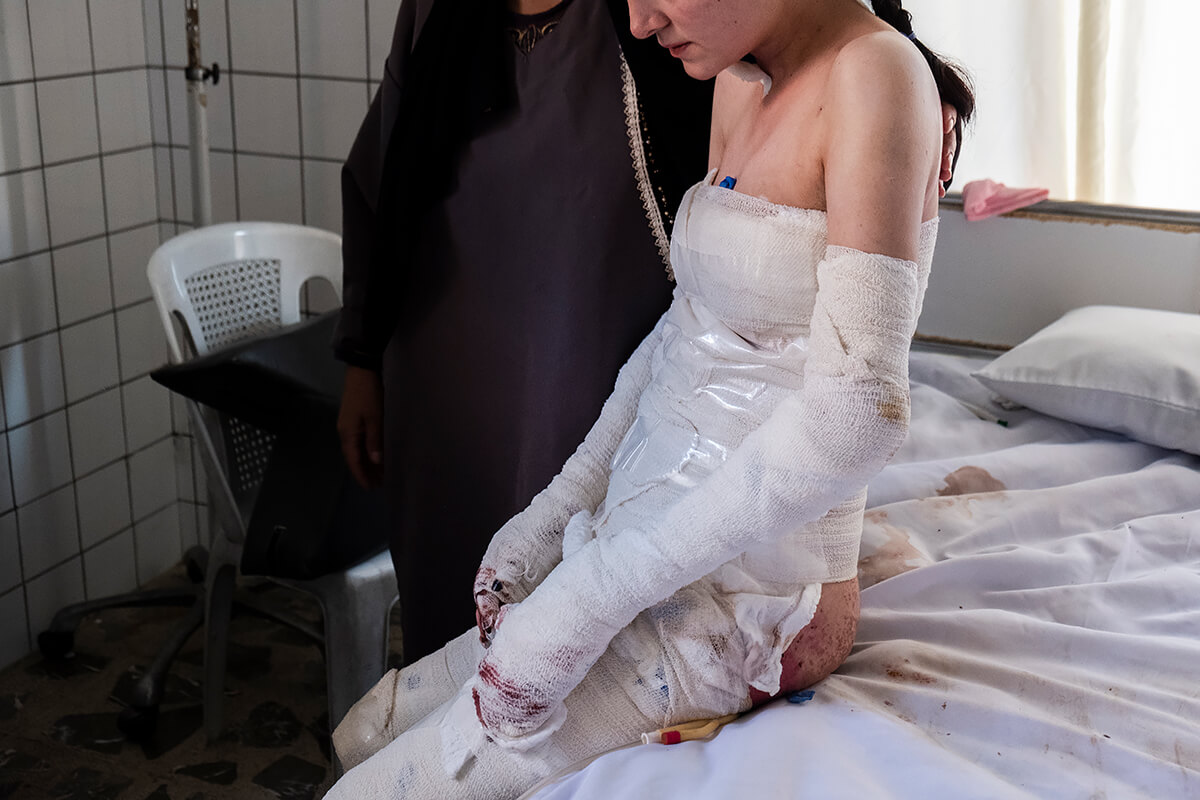
Daroon is trying to stand up, helped by her mother,in order to walk the day before her first surgery. Sulaymaniyah, Kurdistan Region, Iraq, 3 November 2019.When Daroon was engaged at the age of 18 no one from her family imagined that hermarriage wouldend it like this. Two yearsafter she suddenly decided to end her life by setting her body onfire. A moment later she regretted her decision but it was toolate and almost 30 percent of her body was burned and she spentthe next three months in emergency hospital in Sulaymaniyah, Iraqi Kurdistan
The work ranges from series documenting the effects of climate change in Afghanistan; the psychological effects of the crisis in Venezuela; Arba'een, the largest yet little reported Muslim pilgrimage in Iraq; the Rikbaktsa tribal peoples of the Amazon facing the pandemic; the loss, trauma and memories of the Yezidis of Sinjar in north-western Iraq; the security abuses of young people in the fight against gang violence in El Salvador; and the story of women in Iraqi Kurdistan who have tried to escape domestic violence by setting themselves on fire.
The FotoAward, now in its fourth year, and previously won by esteemed photojournalists such as Anna Filipova (2019), Özge Sebzeci (2018) and Rebecca Conway (2017), is designed to recognise women documentary photographers working on projects which aim to bring about real change on contemporary issues, and which may be unreported or under-reported. Nicky Woo-Quamina will receive £2000 towards the completion of her project As The Water Comes and in an unprecedented decision, the judges have awarded a small grant of £250 to runner up, Solmaz Daryani, towards the completion of her project Afghanistan: Between Climate and Conflict along with issuing the six other Honourable Mentions.
Nicky Quamina-Woo commented,
We can be so isolated as documentarians, putting days, weeks, or months into the work, endeavoring to share stories - often independently with no concrete idea if our creative and storytelling efforts will resonate with others. This award is especially heart-warming for me, as the judges chose work highlighting climate change in Africa, with its abundant natural resources, which is so often overlooked when it comes to environmental issues, though it suffers heightened effects of things like desertification and erosion.
Esteemed US born and UK-based photographer, Marilyn Stafford set up the FotoAward in 2017 to help support photojournalism's new generation of women. Stafford herself shot to international acclaim after her work documenting Algerian refugees in Tunisia famously made the front page of The Observer in 1958, bringing their plight to the attention of the world.
Marilyn Stafford said,
It was with great difficulty that the judges made their selections and we would have given a prize to everyone were that possible. My heartfelt congratulations go to Nicky Quamina Woo, our 2020 FotoAward winner, and to Solmaz Daryani as runner up, for their beautiful photography and the sensitive way they approach their subjects. May your projects see a most successful completion and reception. We are proud to have played a part in them along the way.
In recognition of the work women documentary photographers do to highlight important global issues, Nikon have supported the Award since 2019.
Rebecca Newton, PR & Social Media Manager, Nikon added,
Nikon feels incredibly privileged to support the Marilyn Stafford FotoReportage Award for a second consecutive year. The submissions this year were overwhelming - so much talent and so many crucial projects. It was a tough decision but ultimately, Nicky Quamina Woo's combination of stunning composition and awareness for solutions and development around climate change in Senegal proved a unanimous favourite
FotoDocument has facilitated the Award since its inception in 2017 in line with its aims to support and showcase solution-focused documentary photography.
Nina Emett, Director, FotoDocument, said,
We were overwhelmed with the quality of the submissions, which came from every continent and covered so many important local and global themes. We offer huge congratulations to the overall winner, US photographer, Nicky Quamina-Woo, for her outstanding work on climate change in Senegal, Africa, a greatly under-reported issue. In an unprecedented move, we decided to bestow a runner up Award to Iranian photographer, Solmaz Daryani, for her impressive work on climate solutions in Afghanistan. There are so many talented women documentary photographers out there working tirelessly on issues they feel passionate about, often underfunded and usually in challenging circumstances. We hope that this FotoAward and the Honourable Mentions help, in some way, to provide continued motivation.
About the award:
The
Marilyn Stafford FotoReportage Award of £2000, facilitated by FotoDocument and supported by Nikon, is granted to a professional woman photographer towards the completion of a compelling and cohesive documentary photo essay, which addresses an important social, environmental, economic or cultural issue, whether local or global.
The work should, in part, showcase positive solutions to any issues it raises in order to contribute to constructive photojournalism, in line with the wishes of Marilyn Stafford and the aims of FotoDocument. The Award is reserved solely for documentary photographers working on projects which are intended to make the world a better place and which may be unreported/under-reported.
Women from any stage of their careers are welcome to apply, whether emerging, mid-career or established. They must already have started the photo essay for which they are seeking funding and be able to show work in progress. In addition, they must have already completed at least one other documentary photo essay to demonstrate track record prior to applying for funding. Entrants must be over 18, they may be any nationality and based anywhere in the world. It is free to submit.
Submissions are reviewed by international panel including: Donna De Cesare - award-winning Photojournalist & Educator, Nina Emett - Documentary Photographer & award-winning Director of FotoDocument, Melanie Friend - Documentary Photographer & Educator, Rebecca Newton - PR & Social Media Manager Nikon, Neo Ntsoma - award-winning Photojournalist, Marilyn Stafford herself and her daughter, honorary judge, Lina Clerke.
Marilyn Stafford
Marilyn Stafford was born in Cleveland, Ohio, USA. Her photography career was accidently launched in New York in 1948 when friends asked her to photograph Albert Einstein. Marilyn has gone on to cover a wide range of subjects including refugees, tribal peoples, international fashion and prominent historical figures. Despite retiring in 1980, she continues to pave the way for aspiring female photojournalists, setting up the Marilyn Stafford FotoReportage Award in 2017 to provide a platform to promote the work of talented women photographers and to help redress the balance in a male-dominated industry. Marilyn now lives on the south coast of England.
Marilyn Stafford
FotoDocument
FotoDocument is a unique not-for-profit arts education social enterprise that brings visibility to positive social and environmental initiatives around the world through visual story-telling. At FotoDocument we believe in the power of visual imagery as an effective communication tool to harness public attention and engage people in powerful storylines which create a sense of active global citizenship. Nina Emett is founding Director of FotoDocument, where she has worked as commissioner and curator since its inception in 2012. In 2015 she won a PEA (People Environment Achievement) Award for FotoDocument's acclaimed One Planet City environmental project.
FotoDocument


